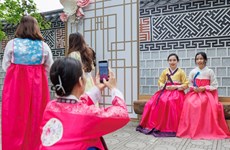Famous artist in the spotlight at L'Espace
A talk on one of Vietnam’s top painters in the 20th century, To Ngoc
Van (1906-1954), who left over a strong imprint with works and artistic
ideas of deep influence on the Vietnamese fine arts, will be held at
L'Espace in Hanoi on December 6.
A talk on one of Vietnam’s top painters in the 20th century, To Ngoc
Van (1906-1954), who left over a strong imprint with works and artistic
ideas of deep influence on the Vietnamese fine arts, will be held at
L'Espace in Hanoi on December 6.
The event will feature an introduction to the painter's works by Professor Chu Hao, while Thai collector Tira Vanictheeranont will talk about how he came to collect hundreds of paintings and sketches by Van. Vanicthreeranont will also speak about a book on the noted painter's sketches that will be published soon.
Artist Phan Cam Thuong, who has already published a book on the painter's works called "To Ngoc Van – Tam guong phan chieu xa hoi Viet Nam 1906-1954" (To Ngoc Van – A mirror reflecting the Vietnamese society in 1906-1954), will speak about his research into his mentor's works.
Having a passion for the art of painting when he was still young, To Ngoc Van left the Buoi Secondary School early to study the art. He then entered the Indochina Fine Arts College to learn oil painting in the 1926-1931 period. His talent was soon recognised right on the first days in the college. Three of his works then "Anh mat troi" (Sunlight). "Bui chuoi ngoai nang" (Banana bush in the sunshine) and "Troi diu" (It’s a mild sky) attracted public attention.
Dynamic and keen to learn, he was compelled by his love to art to read every book, magazine or newspaper article related to arts that he was able to get his hands on. Each picture, be it a folk print of Dong Ho or Hang Trong, a Japanese wood carving, a Chinese watercolour, an Ajanta fresco, a modern Western painting by Manet, Gaugin, Van Gogh or Matisse, filled the soul of the art-loving young man. He studied oil painiting but he also tried other mediums such as silk painting, wood carving and frescoes.
Graduating from the Indochinese Fine Arts College, To Ngoc Van was passionate about the beauty of the diverse spectrum of colours. His skills had been perfected, his later style was basically established. There was a keen sculptor in him who was very sensitive to full, round and graceful figures, especially to the beauty of the female form.
Not only a talented painter, To Ngoc Van was also an outstanding lecturer and a respectable teacher of the first generation of painters in the revolutionary fine arts. He used to give training in Phnom Penh (1935-1938) and later the Indochina Fine Art College (1939-1945).
In many places, from the Central Highlands to Viet Bac (Northern Vietnam), an apt and pleasant artist was seen at times painting a poster on a patch of wall to inspire the resistance; masking and decorating a folding stage; printing leaflets under a curtain of jungle leaves; running the Resistance Culture Group; or managing the reorganisation of the Fine Arts College (1949-1950).
He lived amid his compatriots, sharing every joy and sorrow with the ordinary people, with the combatants and with hard-working farmers, who brought him the inspiration to create new works of art such as "Ha Noi vung len" (Hanoi rose up), "Giac den giac di" (Enemies came and went), "Nu y ta" (Medical maid). These works signalled the initial changes taking place in him. His themes and characters began to change, getting more dynamic and lively, and focusing on depicting action.
To Ngoc Van was considered one of the first painters using oil paint in art works in Vietnam. His paintings such as "Bac Ho o Bac Bo Phu" (President Ho Chi Minh in Tonkin Palace), "Thuyen tren song Huong," (Boat on Perfume River), "Thieu nu ben hoa hue" (Young woman by tuberose) etc. and sketches describing the rural landscapes and the resistance war against the French show a special talent, a sensitive soul, an enthusiastic heart and a patriotism.
To Ngoc Van continuously received valuable prizes: Gold Medal at Colony Exhibition in 1931 with the oil painting "Buc thu" (The Letter), Certificate of Honorary Commendation at French painters’ exhibition in 1932, Certificate of Commendation at Vietnam Fine Art Association’s exhibition. In 1933, his silk painting "Gia Dinh Viet Nam" (Vietnamese Family) was chosen for displaying at the Paris Colony Museum and he was elected member of the French Painters’ Association.
In addition, he won several honourable domestic prizes, such as the first prize at the National Fine Arts Exhibition held in Hanoi in 1954. Many of his works are displayed at the Vietnam Museum of Fine Arts, other overseas museums and private collections.
He sacrificed on June 17, 1954 in Da Khe, Dien Bien Phu battlefield when he was creating works. He was posthumously awarded the Ho Chi Minh Prize for the Literature and Art and the Independent Order, 1st class, in 1995. As a tribute to To Ngoc Van, streets in Hanoi and Ho Chi Minh City bare his name.-VNA
The event will feature an introduction to the painter's works by Professor Chu Hao, while Thai collector Tira Vanictheeranont will talk about how he came to collect hundreds of paintings and sketches by Van. Vanicthreeranont will also speak about a book on the noted painter's sketches that will be published soon.
Artist Phan Cam Thuong, who has already published a book on the painter's works called "To Ngoc Van – Tam guong phan chieu xa hoi Viet Nam 1906-1954" (To Ngoc Van – A mirror reflecting the Vietnamese society in 1906-1954), will speak about his research into his mentor's works.
Having a passion for the art of painting when he was still young, To Ngoc Van left the Buoi Secondary School early to study the art. He then entered the Indochina Fine Arts College to learn oil painting in the 1926-1931 period. His talent was soon recognised right on the first days in the college. Three of his works then "Anh mat troi" (Sunlight). "Bui chuoi ngoai nang" (Banana bush in the sunshine) and "Troi diu" (It’s a mild sky) attracted public attention.
Dynamic and keen to learn, he was compelled by his love to art to read every book, magazine or newspaper article related to arts that he was able to get his hands on. Each picture, be it a folk print of Dong Ho or Hang Trong, a Japanese wood carving, a Chinese watercolour, an Ajanta fresco, a modern Western painting by Manet, Gaugin, Van Gogh or Matisse, filled the soul of the art-loving young man. He studied oil painiting but he also tried other mediums such as silk painting, wood carving and frescoes.
Graduating from the Indochinese Fine Arts College, To Ngoc Van was passionate about the beauty of the diverse spectrum of colours. His skills had been perfected, his later style was basically established. There was a keen sculptor in him who was very sensitive to full, round and graceful figures, especially to the beauty of the female form.
Not only a talented painter, To Ngoc Van was also an outstanding lecturer and a respectable teacher of the first generation of painters in the revolutionary fine arts. He used to give training in Phnom Penh (1935-1938) and later the Indochina Fine Art College (1939-1945).
In many places, from the Central Highlands to Viet Bac (Northern Vietnam), an apt and pleasant artist was seen at times painting a poster on a patch of wall to inspire the resistance; masking and decorating a folding stage; printing leaflets under a curtain of jungle leaves; running the Resistance Culture Group; or managing the reorganisation of the Fine Arts College (1949-1950).
He lived amid his compatriots, sharing every joy and sorrow with the ordinary people, with the combatants and with hard-working farmers, who brought him the inspiration to create new works of art such as "Ha Noi vung len" (Hanoi rose up), "Giac den giac di" (Enemies came and went), "Nu y ta" (Medical maid). These works signalled the initial changes taking place in him. His themes and characters began to change, getting more dynamic and lively, and focusing on depicting action.
To Ngoc Van was considered one of the first painters using oil paint in art works in Vietnam. His paintings such as "Bac Ho o Bac Bo Phu" (President Ho Chi Minh in Tonkin Palace), "Thuyen tren song Huong," (Boat on Perfume River), "Thieu nu ben hoa hue" (Young woman by tuberose) etc. and sketches describing the rural landscapes and the resistance war against the French show a special talent, a sensitive soul, an enthusiastic heart and a patriotism.
To Ngoc Van continuously received valuable prizes: Gold Medal at Colony Exhibition in 1931 with the oil painting "Buc thu" (The Letter), Certificate of Honorary Commendation at French painters’ exhibition in 1932, Certificate of Commendation at Vietnam Fine Art Association’s exhibition. In 1933, his silk painting "Gia Dinh Viet Nam" (Vietnamese Family) was chosen for displaying at the Paris Colony Museum and he was elected member of the French Painters’ Association.
In addition, he won several honourable domestic prizes, such as the first prize at the National Fine Arts Exhibition held in Hanoi in 1954. Many of his works are displayed at the Vietnam Museum of Fine Arts, other overseas museums and private collections.
He sacrificed on June 17, 1954 in Da Khe, Dien Bien Phu battlefield when he was creating works. He was posthumously awarded the Ho Chi Minh Prize for the Literature and Art and the Independent Order, 1st class, in 1995. As a tribute to To Ngoc Van, streets in Hanoi and Ho Chi Minh City bare his name.-VNA













